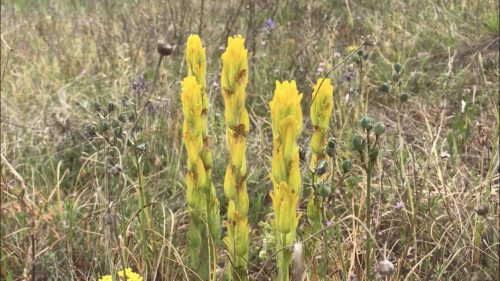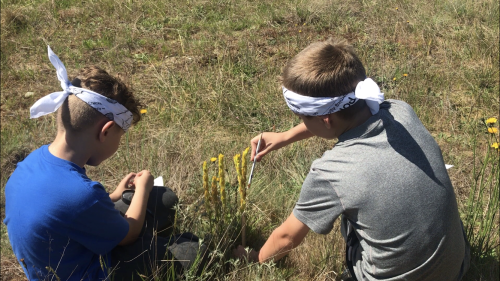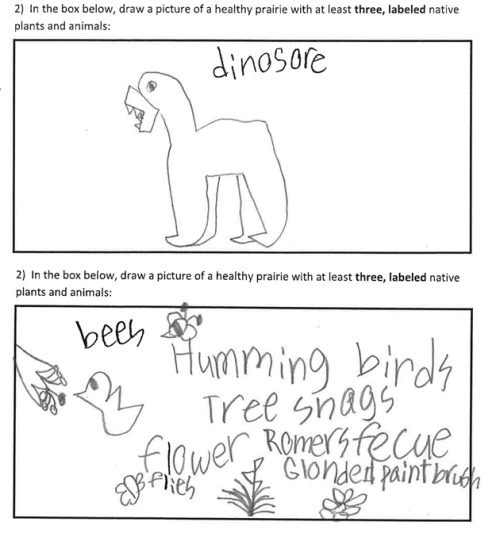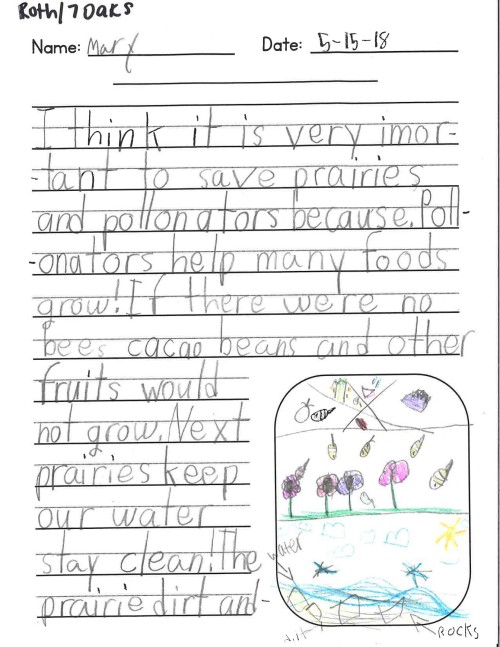Bee-yond the Classroom: Exploring Rare Prairie Ecosystems Gives Kids Conservation Buzz
By Ruthie Aldrich, AmeriCorps Service Member, Conservation Educator
Blogger’s note: Ruthie Aldrich is presently a Washington Service Corps AmeriCorps member serving with our staff in Lacey, Washington. Our hardworking Service Members and interns have some pretty cool experiences during their time with the Fish and Wildlife Service and are often inspired to write about them. Read more of Ruthie’s Stories of Service here and check out more Intern Adventures here.

Photo: Golden paintbrush (castilleja levisecta) is listed as threatened and is unique to our region.
From far away, prairies may look to some like merely a grassy, barren landscape. This is part of their magic: the closer you get, the more you discover. Prairies host a wide array of magnificent biodiversity, from Yellow-faced bumble bees to Golden Paintbrush to Mazama Pocket Gophers. All you have to do to find them is take a closer look.
Golden paintbrush (castilleja levisecta) is listed as threatened and is unique to our region.
South Puget Sound prairies are an especially rare and unique ecosystem. Today, only 10% of historic prairie habitat in the region remains, and only 3% of that is protected or in good condition. Decline in prairie habitat is largely due to urban development, loss of natural and prescribed fire, and woody or invasive species encroachment. Prairies are home to many incredible species found nowhere else in the world, including species listed under the national Endangered Species Act, such as the Mazama Pocket Gopher (threatened), Taylor’s Checkerspot Butterfly (endangered), Streaked Horned Lark (threatened), and Golden Paintbrush (threatened). Prairies also have cultural significance in the region: Camas flowers, a native prairie plant species, were, and continue to be one of the most important foods and cultural staples of western North American indigenous peoples. The root bulb can be dug up, steamed, and eaten, tasting somewhat like a sweet potato. It is said that Camas was historically almost as valuable as salmon for trade between peoples in this region. Prairies also play a key role in cleaning our groundwater, as the soils clean our water before it gets to our drinking water and estuaries.
Despite the importance of south Puget Sound prairies, their existence is usually not common knowledge, even among Washington residents who live alongside it. This does not exclude myself: even though I grew up in western Washington, I never knew that our state is home to one of the most uncommon and extraordinary habitats in the world. That is why my work with the Prairies and Pollinators Project has been so important to me: to ensure that other Washington residents don’t have to wait until they’re in their 20s to discover the majesty right in their backyard.
The main goal of the Prairies and Pollinators Project is to connect 2nd grade students in Thurston County to south Puget Sound prairie habitat through standards-aligned curriculum and hands-on field experiences. My Americorps counterpart and I worked together to develop curriculum materials for teachers to use to teach their students about prairies and pollinators. We then hosted a professional development training for the teachers so we could demonstrate the lessons they’d be doing with their students, such as flower dissections and a game called “pollinator tag.”

Photo: Teachers at the professional development training practicing a fruit dissection activity.
After doing classroom visits at the participating schools, we took over 800 students out onto the prairies for field trips at locations such as Glacial Heritage, Wolf Haven International, and Mima Mounds. The students had been spending time in the classroom learning about prairies and pollinators, and that background knowledge became tangible once they saw it in action.
For the field trips, students rotated through four different stations: a “sit spot” in which they quietly sat and used their senses to observe their environment, a scientific illustration station where they examined prairie plants and insects up close, a station for making “seed balls” out of mud and native prairie plant seeds, and a scavenger hunt. The students’ wonder and excitement as they explored the prairies was infectious. They delighted in seeing the plants they had been learning about in class, such as Golden Paintbrush and Common Camas, up close. They used all their senses to discover and connect with the habitat firsthand. It is hard to forget an experience like forming a ball out of mud, compost, and prairie seeds and throwing it out into the grass to help the prairie continue to throw.



Photo 1: Students observing, measuring, and drawing scientific illustrations of Golden Paintbrush.
Photo 2: A student sits amidst a field of Camas blooms while doing a “sit spot” at Glacial Heritage preserve.
Photo 3: One student’s illustration of the four stations (from top left): sit spot, scientific illustration, scavenger hunt, and seed balls.
On one field trip, while we were embarking on our prairie scavenger hunt, a second grader leaned in and quietly whispered to me, “this doesn’t even feel real.” Although the students and teachers brought their own distinctive knowledge, skills, and personalities to each field trip, the students’ pervasive senses of curiosity and enthusiasm were always a constant. They were always so excited to be outside, see what they had been learning about in class in real life, and use their senses to discover and observe new things. The goal of these field trips was not necessarily to impart a specific set of knowledge and information to the students, but rather to primarily spark a connection with and sense of ownership for this incredible habitat, and to get the students outside, observing things firsthand and asking questions.

Photo: This student’ reflection reads: “Today I went to a prairie. My favorite was when we saw the grandfather tree [an impressively large Douglas Fir tree at Wolf Haven]. I also liked when I caught a grasshopper. Then we made seed bombs. Finally we got to do the sit spot. At the prairie I felt happy.”
As part of our Americorps reporting requirements, we were required to give the students a pre-test before they started the curriculum, and then gave them the same test afterwards to see how much they improved. Although I don’t think testing is the only way to determine the success of the program, the differences in responses were quite satisfying (and, at times, hilarious) to look through. As you can see in the two examples below, students went from knowing absolutely nothing about prairies (as cool as a prairie dinosaur would be) from being able to remember, draw, and identify numerous native prairie species.


Photo 1: Students went from the pre test (top) to the post test (bottom), in which they were able to identify native prairie species such as hummingbirds, tree snags, Roemer’s Fescue, Golden Paintbrush, and flies.
Photo 2: Students went from the pre test (top) to the post test (bottom), in which they were able to identify species such as Camas, Scotch Broom, Golden Paintbrush, bees, moles, and Streaked Horned Larks.
Students these days spend so much time inside the four walls of their classrooms. Environmental and place-based education gets students outside, makes learning relevant to their everyday life, and connects it to tangible experiences. Hopefully, these visits to the prairies will be memorable learning experiences for the students, and will help inspire them to become stewards of south Puget Sound prairies and all the organisms who live there for years to come.

Photo: Student’s reflection reads: “I think it is very important to save prairies and pollinators because pollinators help many foods grow! If there were no bees, cacao beans and other fruits would not grow. Next prairies keep our water stay clean! The prairie dirt and rocks filter out bad things. Last prairie flowers and pollinators work together as a team! Without the other the other would not survive! And that is why I think it is very important to save prairies and pollinators!”
Want to learn more? Check out some of these links:
● Click here to learn more about South Sound Prairies and ways to get involved
● Click here to learn more about the Prairies and Pollinators Project
